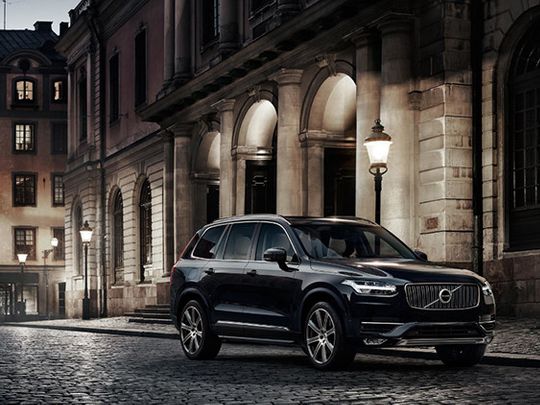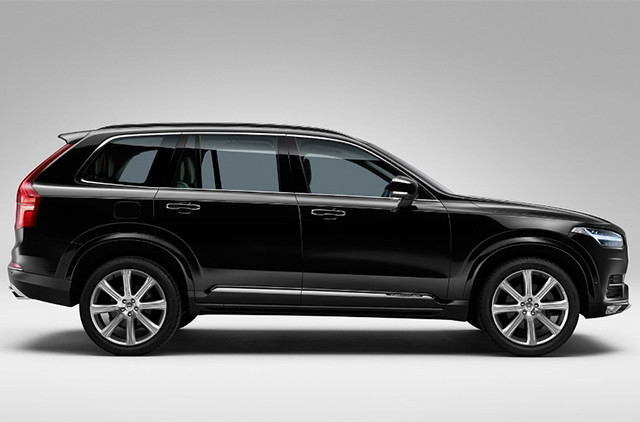
The Volvo XC90, an ebony behemoth, pulls up in front of the house. A mere month old, it boasts a sound system that can simulate the acoustics of Sweden’s Gothenburg Concert Hall, five cameras (a good thing because the bumper is so low and far from the driver’s line of sight that it may as well be in another state ) and more sensors than a Swiss bank or a star in a CGI film.
Also, a brain of sorts to help steer, stop, park and anticipate all the dreadful things that might occur on the road, then seamlessly avoid them. It’s like a fairy god Volvo.
The new generation of semi-autonomous - as in almost-but-not-quite-driverless (yet) - cars, which automakers assure us will soon be tooling about everywhere, represent a smarter mode of transport designed to reduce the biggest problem with driving.
Which would be drivers.
The car not only has a snazzy display panel directly in front of the steering wheel, but also something resembling an iDashboard to the right with a dizzying number of tools, control “tiles” and - not to get too technical - stuff that will prove significantly less distracting and crack-up-dangerous when the car is left to do much of the driving, which is precisely the point.
Eagerly, we await instruction. How? we ask. What? When?
Instead, the delivery man shrugs. Whatever.
“It’s a toy,” he says. “A big toy. Have fun with it.”
He hands us the luggage-leather key fob and pulls off into the morning heat, leaving us alone with the car that is temporarily outsmarting us.
Fun, you say.
We can do fun.
So we do what any smart person would do with a fully loaded, two-ton, $66,000 toy that we haven’t a clue how to operate.
We drive it - or rather we hope it will drive - to the beach.
Cool but weird?
Right around Tanger Outlets in Rehoboth, Delaware, where traffic slows to a parking lot, the thing is pretty much driving itself. (Pilot assistance works only when you’re driving under 30 mph.) It’s staying perfectly in its lane, hugging the curves and gently stopping (no herky-jerky here) with the traffic, with only my thumb lightly on the wheel.
Whoa. This is equal parts bragworthy cool and Knight Riderish weird.
While others curse in traffic, we are liberated and enchanted! Our car is magic! Our car is so much smarter than your car! It’s Phi Beta Carpa!It should have its own university rear-window decal.
It has taken many miles, and more than a few failed attempts on highways along the way, to master the sleek beast. We’re a bit anxious about intentionally driving badly - that’s a job better suited to crash-test dummies - changing lanes without signaling or cutting off another car just to test the Lane Keeping Aid, part of the Driver Alert System, which helps reduce stupid driving.
Not having had proper instruction, we can’t figure out the super-duper automated cruise control, since the buttons beside the steering wheel are understated in that 21st-century way of “if you have to ask, you probably shouldn’t be operating this baby.” It helps to have younger passengers, from the generation raised on a heavy diet of Xbox, fluent in apps and digitally dexterous, to decipher the tablet and all its powers.
And then, deus ex machina, the machine starts to work its magic. Look at us! As the car will accelerate and brake by itself when the smarty-pants cruise control is engaged, we’re driving with no feet, leaving our toes free to tap, curl, possibly be polished, and no hands save for a thumb. Does this feel hugely strange? You bet.
Free hands liberate drivers to do other stuff. Like text, tweet, gesticulate or - I am so sorry to report, though car manufacturers promote this as a bonus - work.
This is huge. Also, awful.
We are perilously close to living in an age where we can work everywhere, all the time and with no more I-was-stuck-in-traffic excuses. (Enjoy!)
How close? Like 2020 close, experts say, with full automation - i.e., driverlessness - arriving possibly five years later. In addition to Volvo, Mercedes and BMW already have semi-autonomous vehicles. Google just put on the road around Silicon Valley little self-driving cars (albeit still with a human behind the wheel) that look like they were hatched by a Pixar hen. Mercedes has a driverless concept car that, to assert its awesomeness, has two seats that can face backward, so a quartet of passengers can conference or party or play a round of bridge while the car transports them to their destination.
The kids are in love, glued to the iDashboard. They want the car. Now. They want to jettison the old, stupid car that knows nothing, could never be confused with a toy and, by comparison, seems as savvy, modern and comely as a mule.
Moods and modes
The car has many moods, or modes, though it’s calm enough to keep them in check. From a control setting next to the gear shift, it can drive eco for the Prius-minded. It can drive comfort for the luxury crowd and dynamic for the sporty. Also, for the FOMO adventurer, it can go off-road. (This is a loaner, however, and off the road we do not go.)
We are on the interstate to central New Jersey heading for a lesson, the one we had hoped for days earlier.
On the slower patches of I-95, the behemoth drives while the non-driver, I am sorry to report, works, checking email and responding to texts. The Volvo moves perfectly, stopping a car length behind the vehicle in front, which doubles as a herding animal. This car needs a car in front of it to sense how fast to drive and when to stop. Otherwise, it hasn’t a clue.
In this regard, and possibly in this regard only, it resembles a large, slow Swedish sheep.
The car is not only smart but faultlessly polite. When the driver tries to change lanes without signaling or consulting the blind spot sensors (a grand invention, prizes have been given for less), the vehicle resists and emits gentle vibrations in the steering wheel and a flashing light in the side mirror, as if to admonish, yet with the utmost discretion - really, you can drive better than this. A more audible or dramatic scold might embarrass the driver in front of passengers. The smarter car is a diplomat and a couples counselor, reducing rage, argument and profanity, all of which tend to increase exponentially with traffic.
In a mall parking lot, Volvo of North America spokesman Jim Nichols demonstrates how the XC90 can park itself, parallel and perpendicular, which is simultaneously scary and amazing in an amusement-ride kind of way.
Mostly, it makes me nervous, in a rising-insurance-premium kind of way.
On an early weekday morning, the mall lot is blissfully auto-free, spaces abound, and the sensors are searching for other objects, boundaries, so the car can back up, angle, pivot and park. It’s the automotive version of the Barbra Streisand song “People.” These cars need other cars.
After cruising around, the big toy with its five cameras finds several spaces and parks perpendicularly. And perfectly.
If you ask me, self-parking cars can be viewed as an affront to the art of driving, a world where fewer people will know how to parallel park or need to.
Being a superior parallel parker, as Calvin Trillin has noted, is one of life’s unheralded skills. It’s a talent that can actually improve with age and occasionally astonish passengers. With semi-autonomous technology, cars will make driving so easy that it might not resemble driving at all, in much the same way that frozen food and microwaves barely resemble cooking.
There are many, many good things about smarter cars, the most important being that they will drastically reduce serious accidents, stopping the driver from doing harm. Hell, as we well know, is other drivers. Globally, 1.2 million people die every year from car accidents, 93 percent due to human error, according to Carnegie Mellon engineering professor Raj Rajkumar, who is working on driverless technology.
“People are going to knock the door down for them,” predicts Princeton professor Alain Kornhauser, author of the Smart Driving Cars blog, who has driven a semi-autonomous Mercedes-Benz S-Class for a year.
Smarter cars “are good for old people. They’re good for blind people. They’re good for young people,” Kornhauser says.
It gets better. “They’re bad for lawyers. They’re bad for car repair shops. They’re bad for hospitals, where there will be fewer MRIs. They’re bad for undertakers.”
Kornhauser pauses. “Nah, they’ll get us anyway.”
Woman vs machine
Heading home, sometimes I let the car drive, but sometimes I reestablish dominance over the machine.
Relinquishing control of a two-ton, $66,000 vehicle may prove the ultimate challenge for people who prefer to be in control at all times.
Which would be much of the East Coast population.
The biggest problem with this new generation of cars may be emotional. We have complicated, irrational, romanticized relationships with our cars, anthropomorphic tendencies and magical thinking connected to a hulk of glass and metal.
We decorate them, name them, mourn their demise. We use them as billboards to boast about education, team allegiance and travel. We tend to believe that red cars are sexier, Subarus are sensible, Corvettes are symbolic of other issues, and BMWs are driven by Type As who, should you pass them on the highway, will be compelled to pass you and reassert dominance
We believe, foolishly, aspirationally, that driving confers control and power when much of the time it does neither.
We believe that driving is sexy, romantic and liberating, a windswept-hair excursion down Pacific Coast Highway, when actually life is perpetually stalled on the Beltway.
These cars, manufacturers argue, are necessary to the reality of driving, which is often about traffic and parking
Thirty to 35 per cent of city driving is circling blocks looking for parking, says Rajkumar, though sometimes it feels like so much more. “Imagine if you could get your car to park itself and appear when you needed it,” he says. Instead of arriving late for dinner, you could simply tell the car, Go park yourself.
The $66,000 big toy was a blast to drive - or to let it drive - once I surrendered control, its superior sense of the road was humbling. Days later, I missed its smart, cool calm.
The real car remains as savvy, modern and comely as a mule. But I always get to drive.
Washington Post












